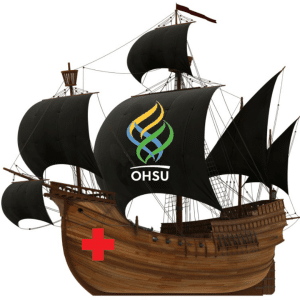OHSU: Savior or Privateer?
The good ship OHSU offers refuge from troubled seas to Legacy’s fleet of hospitals and clinics
Oregon entered unchartered waters last week with the announcement that Legacy Health System, a private healthcare provider, would ‘merge’ with the state-sponsored Oregon Health and Science University. While the word ‘merger’ has a softer and gentler tone, make no mistake — this is an acquisition. Mergers generally are distinguished as two entities coming together to form a new organization, new name, and new governance structure. In this proposal, OHSU will be the surviving entity and will continue to be governed by its board of directors.
 In my previous career, hundreds of mergers and acquisitions crossed my desk. As a financial regulatory agency, our role in approval or disapproval was based solely on the safety and soundness of the transaction as it pertained to any negative impact on the federal insurance fund. In this instance, as a state entity, the insurance backstop for OHSU is ultimately the Oregon taxpayer.
In my previous career, hundreds of mergers and acquisitions crossed my desk. As a financial regulatory agency, our role in approval or disapproval was based solely on the safety and soundness of the transaction as it pertained to any negative impact on the federal insurance fund. In this instance, as a state entity, the insurance backstop for OHSU is ultimately the Oregon taxpayer.
Legacy Health lost a staggering $172 million in the last fiscal year. It has been desperately trying to sell off assets or close facilities to promote consolidation, but the latter has been met with intense political pushback from local and state legislators. This spring, the rating firm Moody’s, downgraded Legacy’s debt outlook from stable to negative.
“An additional factor behind the negative outlook is our expectation that Legacy will fail its quarterly debt service coverage test on several bank agreements for the next couple of quarters.”
Moody’s, April 2023
OHSU has a strong balance sheet in its investment portfolio, but rating agencies are increasingly cautious even with that. On June 22 of this year, S&P Global maintained OHSU’s rating at AA- but changed its outlook from stable to negative, citing OHSU’s “ambitious capital strategy.”
While OHSU has entered into partnerships with private entities before, a total acquisition of a large private business is an historic action. There is also a jurisdictional question. Legacy Health owns a large hospital, Legacy Salmon Creek Medical Center, in Washington state. It is like the state-sponsored workers’ compensation fund, SAIF, buying its private competitor Liberty Northwest Insurance. Or how about the Oregon Lottery buying DraftKings?
The terms of the acquisition are sketchy and deserve scrutiny. Will the 14,000 Legacy employees now become employees of the state? Will they all be eligible for PERS, the state’s pension system, or will they remain in their current pension plan? In either case, OHSU will become responsible for the existing pension funds liabilities. Many pension funds, like PERS, have significant underfunded liabilities. Where does the Legacy pension fund stand?
Then there is the State Tort Claims Act. The Legislature extended special legal protections to OHSU by capping its exposure to costly lawsuits. Will that special treatment now be extended to the large expanse of Legacy’s providers? The extension also could help slow the rising cost of malpractice insurance to more providers. However, that is likely not to be cause for a celebratory cocktail reception by Oregon’s trial lawyers.
Of course, there is also the concern of the contentious golden parachute. Mergers and acquisitions are almost always heralded as reducing redundancies and improving efficiency. Many Legacy executives may no longer find a need for their services. What will be the cost of securing their smiles and kind words at a future ribbon cutting? If OHSU can buy, could they later sell all or parts of its new collection?
And what does this do to the competitive landscape of Oregon healthcare? State and national hospital associations always tout these consolidations as improving the quality of care and reducing costs. But recent studies by Rand and Harvard have concluded that most hospital mergers fail to improve quality and actually increase costs. If completed, this acquisition will create Portland’s largest hospital system and further expand OHSU’s already powerful political influence on state healthcare policy.
As a publicly subsidized entity, OHSU will need to be more specific on WHY this acquisition will be in the larger public interest and HOW it will lower the total cost of care and improve quality in light of mounting evidence that consolidation often does neither. In fact, getting bigger often means more market leverage to demand higher reimbursement from payers.
On the flip side, there may be benefits.
An influx of new PERS members could add immediate liquidity to the pension system to help meet cash flow needs required to meet monthly benefits to existing retirees.
Then there is the Intergovernmental Transfer Agreement which allows OHSU to transfer federal Medicaid dollars to the state to leverage (for a fee) even more federal matching dollars into the state’s healthcare system. Those dollars would likely increase.
A larger question is whether the Oregon Health Authority, which must approve any agreement, can actually conduct an arms-length analysis when the arms of OHA and OHSU are so tightly entwined.
Recent history serves as an illustration. Three years ago, faced with the onset of the COVID pandemic, then Governor Kate Brown secured a “loan” from an OHSU executive to run the state’s vaccine program. This spring, OHSU graciously loaned another of its executives to help run OHA while Governor Tina Kotek sought a new permanent director. Oh, and there’s this: The Board of Directors of OHSU is appointed by the Governor. It is difficult to view OHSU and OHA as anything but two layers of the same cake.
Healthcare providers regularly criticize the Oregon Health Authority for costing them millions of dollars yearly for stacks of redundant reports and data routinely demanded by various OHA divisions that seemingly don’t talk to each other. Excuse the eye-roll from those providers around the state when told to take comfort that OHA will surgically critique the redundancies and efficiencies of the proposed consolidation.
Ultimately, allowing a major healthcare provider to slip into insolvency is not in the public interest. The risk to patient access and care and the potential economic impact on the region demand a proactive solution. Perhaps this is the best outcome. Any acquisition must be transparent and conducted with a keen inventory of the Legacy Fleet’s cargo before this ship of state sails in and the unloading process begins.


